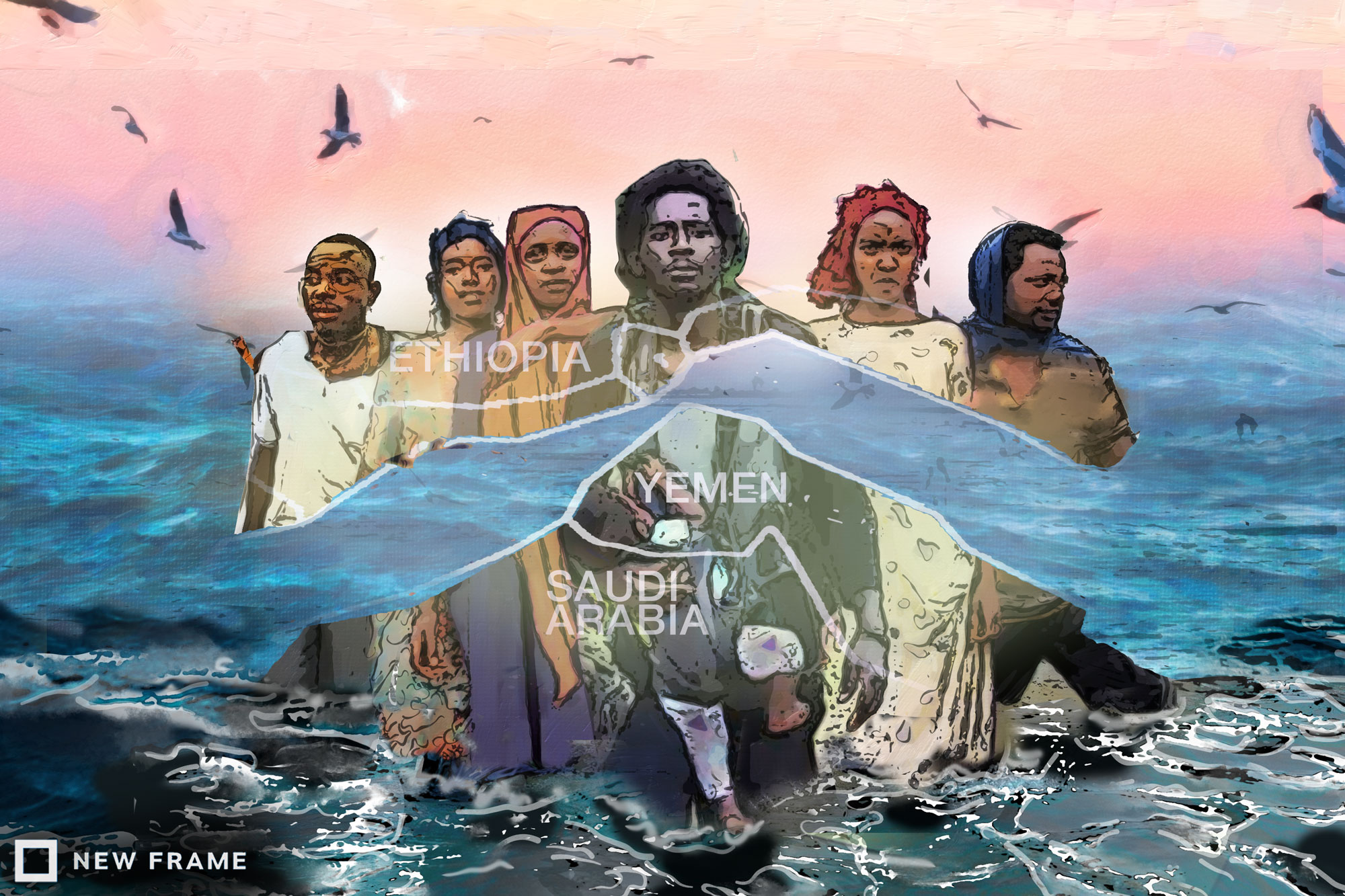Witnessing the hell that a migrant can face
More and more migrants from Africa are choosing the ‘Eastern Route’ over the Mediterranean Sea, risking the Saudi-UAE war on Yemen in search of work only to be periodically deported en masse.
Author:
2 March 2020

At Obock, Djibouti, 2 000 migrants gather each day along the waters of the Gulf of Aden; they look for boats to get them to Yemen. Over the past two years, more migrants from Africa have used the “Eastern Route” rather than go across the Mediterranean Sea; according to the United Nations’ migration agency – International Organisation for Migration – this Eastern Route is now the “busiest maritime migration path on earth”. Roughly 11 500 people got on boats at places like Obock and Bosasso, Somalia, to go into Yemen, and then overland to Saudi Arabia, where they hope to get employment.
Ethiopia
Outside the Horn of Africa, Ethiopia is typically thought of as a country of distress due to the 1983-1985 famine that wracked the country. But over the past few years, according to World Bank numbers, Ethiopia has been one of the fastest-growing countries in the world (after Myanmar and China). On 18 July 2019, the director of the International Monetary Fund’s African Department Abebe Aemro Selassie gave a presentation at the Ethiopian Economics Association. In his presentation, Selassie said that the key reasons why Ethiopia has seen such high growth have been improvements in the productivity of labour and increased investment in capital stock (factories, infrastructure). To make these gains, Ethiopia had to borrow, which has now put it in a position of debt vulnerability.
Related article:
If you just look at the numbers, Ethiopia is doing great. But, not for people in the rural districts, where agrarian distress remains a fact of life. Of those who use the Eastern Route to migrate, over 90% come from Ethiopia, and most of them from the rural districts of Amhara, Oromia and Tigray. The World Food Programme and the Ethiopian government’s data shows us that these districts face terrible food insecurity and that there is a high level of food energy deficiency per adult in rural Ethiopia, with Amhara and Tigray leading the way. There has been barely any exit from the long-term crisis of agriculture in Ethiopia, whose lands are now increasingly threatened by corporations from India and Saudi Arabia and by shifts in the climate.
Neoliberal policies have enabled Ethiopia to grow quickly, but this growth has not been pro-people, certainly not the people of the rural districts of Amhara, Oromia and Tigray, from where the main migration has been taking place.
Djibouti
Djibouti, at the tip of the Horn of Africa, within sight of Yemen, is one of the smallest countries in the world. But it is located at a strategic vantage, at the entrance of the Red Sea. That is the reason why it has been home to a very large United States military base – at Camp Lemonnier. But the US base is no longer the only one; there are substantial bases for the militaries of China, France, Italy and Japan.
For years, there was concern about the rise of piracy in the water off the Horn of Africa, with pirates from Somalia being seen as a major threat to global shipping. But, over the past decade, piracy here has decreased in these waters as it has decreased worldwide. It is clear that none of these bases are in Djibouti to deter piracy, which is their stated goal. They are there because of the geopolitical tensions around the Gulf region.
India and Saudi Arabia are building their own bases in Djibouti, with the Saudis even looking at Obock for land. The United Arab Emirates (UAE), which is prosecuting the war in Yemen with Saudi Arabia, already has military bases in Eritrea, Somaliland and Somalia.
Despite the presence of these forces in such a small country, there is no effective way to prevent the migration of thousands of Ethiopians through Djibouti to Yemen. Neither the ports nor the waters are barriers to this human exodus.
Yemen
The Saudi-UAE war on Yemen has been going on for five years. On 23 February, the parties to the conflict met in Jordan to agree on a prisoner exchange; this fulfils some of the commitments made in the Stockholm Agreement of 2018. A medical air bridge has allowed a handful of critically ill patients to be taken out of Yemen’s capital of Sana’a, while the port of Hudaydah is largely left free for necessary humanitarian goods to enter the country. Almost all of Yemen’s people are reliant upon these humanitarian goods for basic survival.
Despite this relatively good news, violence has escalated in certain key districts of Yemen over the past two weeks. Since January, 35 000 Yemenis have been displaced from their homes, an indicator of the dangerous situation in the country.
Related article:
It is into this cauldron that the Ethiopian migrants come. Crossing the Red Sea is not easy, as the boats are insufficient and overcrowded; migrants who make it to Yemen report that they have seen people leap off the boats to certain death because of the terrible situation that they face. In March 2017, a UAE-Saudi helicopter fired at a boat carrying Somali migrants – killing at least 42 people; there are additional reports of this kind of activity along the Yemeni shoreline.
In Yemen, the migrants are held in detention camps, where they are abused by human traffickers and by other gangsters. Migrants in these camps, including in Aden, face extortion – if they cannot pay the guards, they are beaten, raped and held indefinitely. When the spotlight is shone on any one of these camps, it closes and another opens elsewhere.
Saudi Arabia
If the migrants somehow make it to Saudi Arabia, the terror continues. Smugglers take the migrants into Saudi Arabia’s Jizan Province; often the migrants are made to carry qat (a stimulant grown in Eastern Africa) across the border. They are often shot at by Saudi border guards and – if caught – are either ransomed or held in places such as Jizan Central Prison (which might as well be a detention camp).
Saudi Arabia and Ethiopia have a strangely symbiotic relationship. Saudi Arabia relies upon at least 400 000 Ethiopian workers, who come to do a variety of jobs in the kingdom. But, every few years, Saudi Arabia deports these workers. In 2013, the Saudi government removed 100 000 Ethiopian workers; they were deemed to be “illegal”, arrested and removed in chartered flights. Then, slowly, Ethiopian workers returned, now with lower wages and almost no rights. In March 2017, Saudi Arabia deported 260 000 Ethiopians. These deportations are a disciplinary mechanism, a way to keep the Ethiopian migrants on their toes.
Related article:
Ethiopia conducted agreements with Saudi Arabia (2017) and the UAE (2018) to ensure protections for their citizens, but there is little evidence that this is helping. Both Saudi Arabia and the UAE have been putting billions of dollars into the National Bank of Ethiopia and into its government, part of the foreign direct investment (FDI) that has heated up the Ethiopian economy. Given this money, it is impossible to imagine the government of Ethiopia standing up for its citizens in the Gulf.
The boats from Obock, Djibouti, will continue to ply their trade; Ethiopians will continue to travel the Eastern Route into Saudi Arabia. No plans are afoot inside Ethiopia to be able to generate employment to hold the population in place, and there are certainly no plans in Saudi Arabia to improve the conditions of its workers.
There is a demonstration of values here: when workers come to Saudi Arabia, they have to travel by the dangerous waters and through war-torn Yemen; when they get deported, they are flown home by aircraft.
This article was produced by Globetrotter, a project of the Independent Media Institute.



